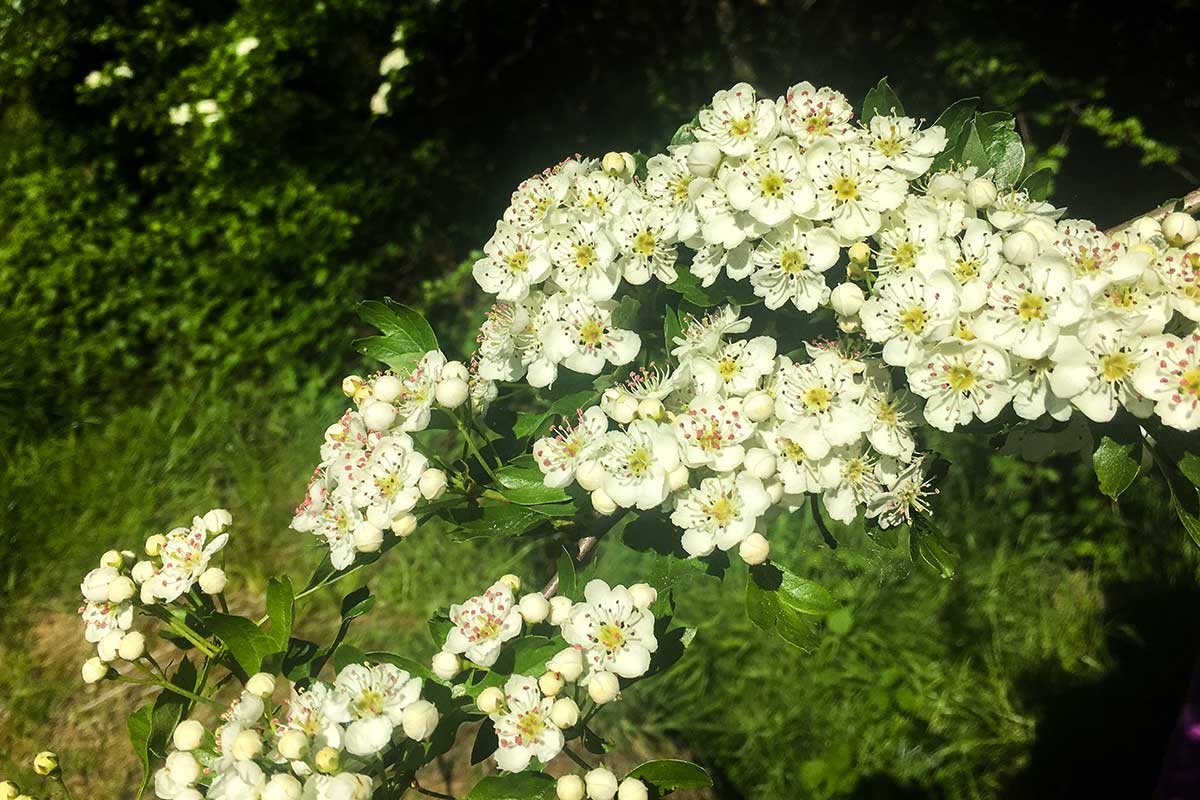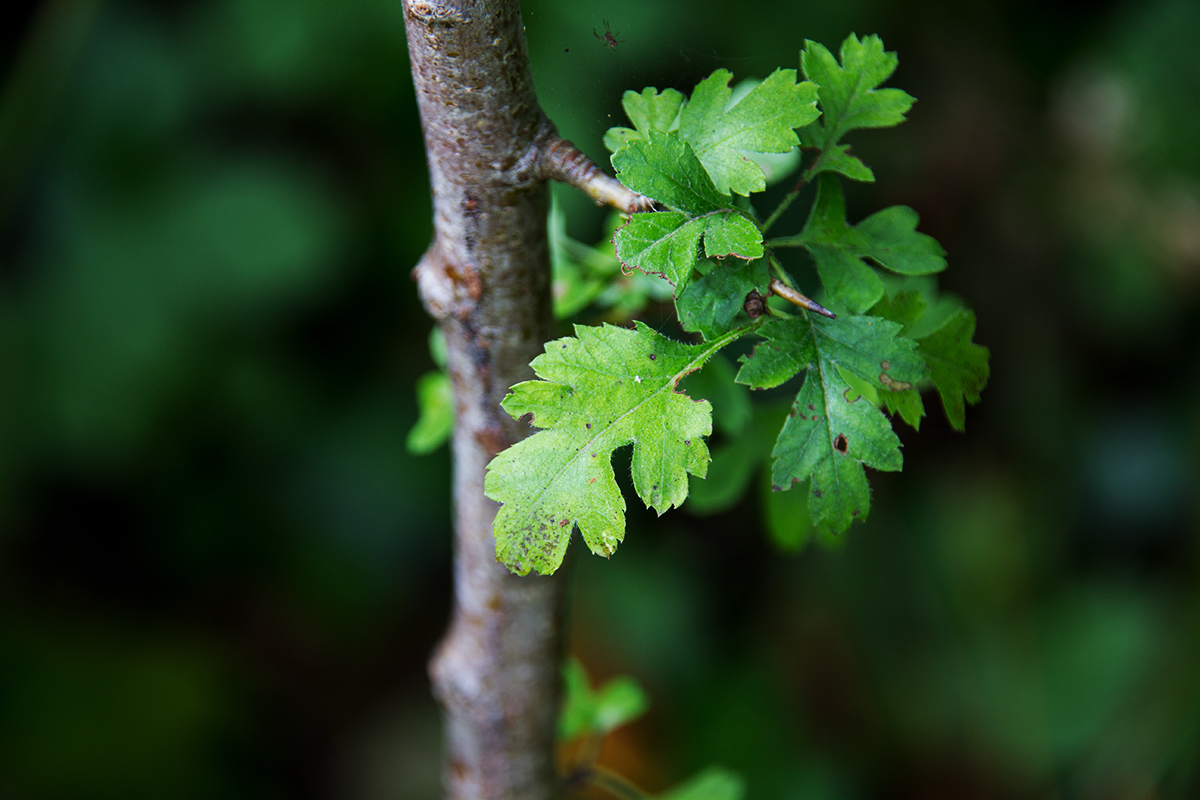Hawthorn
Common names
Latin name
Family
Parts used
Botanical description, cultivation and harvesting
A deciduous shrubby tree with long shoots and short thorny shoots. It has lobed, stipulate leaves and pink to white flowers with 5 petals, short triangular sepals, stamens prominent around nectary and carpels in corymbs. The red berries have mealy flesh and large stones.
The tree grows throughout Europe, North America, and Asia. Crataegus monogyna is the native species in Ireland. Seeds usually take 18 months to germinate, and therefore it is normally propagated from cuttings. The flowers or flowering tops are usually harvested in late spring around May with or without leaves and need to dry quickly but gently. After harvesting in the autumn dry fruit slowly with a little heat, for example in the hot press.
History, folklore, taste and energetics
Ireland is a country of the heart- all that green everywhere. When the forests were cut down, the wolves were extincted and the land was taken away by enclosure and given to the landlords, the only tree that peasants were allow to continue to plant was the hawthorn; hawthorn mends broken hearts and connects us to the other realm. All those hawthorns that burst with blossom in the spring and drip with red berries in the autumn mend broken hearts and are doubly generous as they offer that medicine both in their flowers and their berries. It is a Commoner of the Woods in the Brehon Laws and has an immense amount of folklore attached to it in Ireland. It is known as a fairy tree, one that helps to connect us to the Imaginal Realm and it is considered extremely bad luck to cut one down (indicative of the value placed in its medicine; so strong is the belief here that planned road routes and building plans have been altered to avoid the removal of hawthorn trees. Hawthorn also helps to relieve anxiety and is traditionally thought to mend broken hearts, both emotionally and physically; it is especially helpful at reducing anxiety during menopause and andropause which is a time when many people look back at their regrets and may be struggling to remember who they are, their heart truth. The berries and the medicine made from them have a deep red hue, reminiscent of the colour of healthy blood. Hawthorn was traditionally used to treat kidney and bladder stones until an Irish doctor noticed its benefits for the heart.
The flowers taste cool and astringent; the berries are sweet, sour and warm.
Constituents
Saponins; Glycosides; Flavonoids (vitexin, vitexin-4-rhamnoside, qurecetin, quercetin-3-galactoside); Various acids, including ascorbic; Amines (phenylamine, alpha-methoxyphenylamine, tyramine in flowers); Tannins.
Actions
- Cardiac tonic
- Coronary vasodilator
- Hypotensive or blood pressure regulator
- Relaxant
- Anti-oxidant
- Diuretic
- Mild anxiolytic
Traditional and current uses
- Reputed to dissolve deposits in thickened and sclerotic arteries
- Cardiac failure
- Myocardial weakness
- Myocardial weakness with high blood pressure
- High blood pressure
- Low blood pressure
- Arteriosclerosis
- Buerger’s disease
- Improves peripheral circulation
- Improves circulation to the head and therefore can aid memory
- Paroxysmal tachycardia
- The bioflavonoids relax and dilate the arteries and blood vessels thereby relieving angina
- The bioflavonoids and proanthocyanins are also valuable antioxidants which help repair and prevent tissue damage, especially in the blood vessels
- Benign arrhythmias
- Relieves mild anxiety, especially at menopause or andropause
- Dyspnoea
- Originally used for kidney and bladder stones
Caution: May take a few weeks to show results, although often not. Initially, increased urination may occur – this usually balances out after a few days. Make sure adequate water is taken (at least 1.5 litres a day).
In its action as a peripheral vasodilator to lower high blood pressure and increases blood supply to the tissues; the addition of horseradish and or cayenne can be very helpful. Its vasodilatory properties extend to the arteries of the heart making this herb beneficial for the treatment of coronaries, angina and heart failure. Hawthorn also slows heart rate if too high (chronotrophic) and lowers force of heart contractions if too strong and vice versa (Ionotrophic).
Recipes
For culinary use the berries are traditionally gathered after the first frost which converts some of the starches to sugars (enhancing their sweet/sour taste) and makes the berries more palatable. Berries are used as an ingredient in hedgerow wine, or to make haw jelly as an accompaniment to wild game. The berries can also be mashed, removing the skin and seeds, and used to make a fruit leather as a way of storing them.
The flowering tops and young leaves used in salads as a spring tonic.


